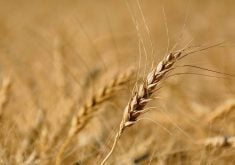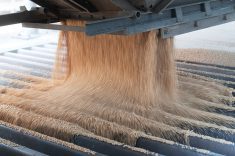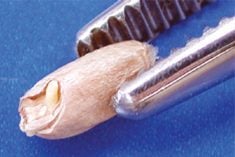The Canadian Grain Commission is working on a plan to reduce its service fees after racking up a surplus since 2013 that is bigger than its annual operating budget.
As of March 31, 2015 the CGC had a $63.3-million surplus, according to its most recent annual financial statement. It’s expected the surplus will have grown this fiscal year, which ends March 31.
CGC commissioner Murdoch MacKay told the Winter Cereals Manitoba meeting here March 16 that will likely mean farmers pay lower fees starting with the 2018 crop, the next time fees are adjusted.
Aug. 1, 2013 Canada’s grain industry, including farmers, was complaining bitterly as CGC user fees, on average, jumped 44 per cent after the government ordered the regulator to be self-sufficient. The CGC’s official outward inspection fee, which pays for part of the renowned ‘Certificate Final’ guaranteeing customers’ grades, tripled to $1.60 a tonne.

“There will be definite changes we will be looking at,” MacKay said, noting farmers produced much larger crops than was anticipated when the per-tonne fees were set.
There were bumper crops the last two years and a record in 2013.
The federal government allocates about $5 million a year to support the CGC’s Grain Research Laboratory, seeing it as a public good. But the CGC, which runs on about $60 million a year, must collect the rest of its money by charging user fees on services such as outward official weighing and grain inspection and licensing grain elevators.
The per-tonne fees were based on the CGC’s estimate that it would inspect 23.3 million tonnes of export grain annually, not including shipments to the United States, which rarely move through export terminals. Canadian grain exports (excluding to the U.S.) averaged 23.3 million tonnes from 1993-94 to 2009-10.
Read Also

Mazergroup’s Bob Mazer dies
Mazergroup’s Bob Mazer, who helped grow his family’s company into a string of farm equipment dealerships and the main dealer for New Holland machinery in Saskatchewan and Manitoba, died July 6 from cancer.
“I can tell you the number we will be using (Aug. 1, 2018) will be much higher than 23.3 million (tonnes),” MacKay said. “Let’s say if we go to 30 million tonnes (for exports), that’s seven million more tonnes of grain we’re going to handle so what do you think will happen to our fees?”
In a later interview, MacKay stressed the CGC must maintain some surplus so it can operate when crops fail or exports decline, resulting in less revenue.
“How much of a surplus? Those are things we’re looking at,” MacKay said.
He also said CGC’s user fees had been frozen since 1991 — 22 years — by successive federal governments. Before 2013, user fees only covered half of the CGC’s operating costs. Current user fees would have been even higher had the government not made inward terminal inspection voluntary. It had been mandatory.
While the current fee schedule includes small annual adjustments for inflation, fees must be renewed every five years. The CGC is required to consult with the industry first. It’s a formal and time-consuming process, which is why consultations start this fall, MacKay said.
During the first two crop years after the new fee was implemented, Canadian grain exports (excluding to the U.S.) averaged almost 36 million tonnes — 13 million more than expected.
During the previous five crops years (2012-13 to 2008-09) exports (excluding to the U.S.) averaged 28.2 million tonnes or almost five million tonnes more than the CGC projected.
The CGC’s surplus doesn’t trouble Keystone Agricultural Producers (KAP) president Dan Mazier.
“The fact they are willing to adapt and not charge as much is a much easier conversation to have than telling us they have to increase our costs,” he said in an interview March 18.
“If they reduce the user fees I’m very much in favour of that. The bottom line is we’ll pay less for the services they render.”
The Western Grain Elevator Association (WGEA), which represents the West’s major grain companies, welcomes consultations, said association executive director Wade Sobkowich. But he added they should start with the government agreeing to pay more of the CGC’s costs because much of what it does is for the public good.
“We’re not sure if the user fee consultations will deal with that, but we think that’s the first question that needs to be answered,” he said.
Grain companies are willing to pay the true costs of CGC outward grain weighing and inspection, but not unrelated CGC costs, Sobkowich said. Ottawa should cover costs connected to the CGC’s head office, policy department, trade missions and the Grain Research Laboratory, he said.



















